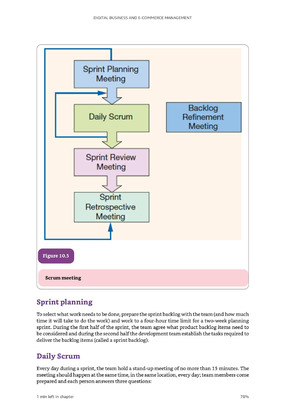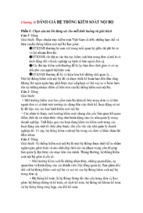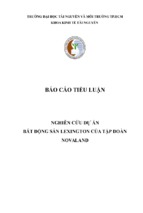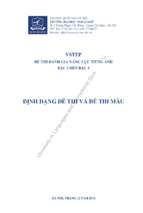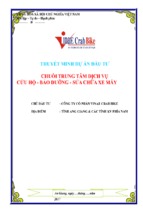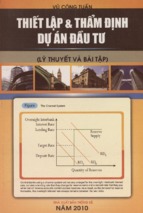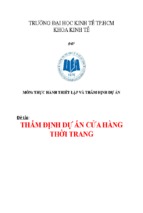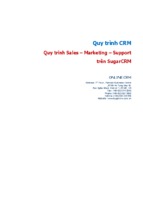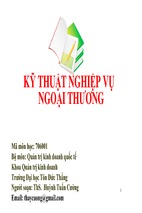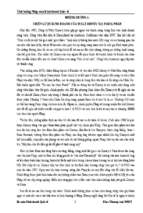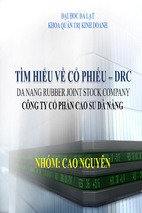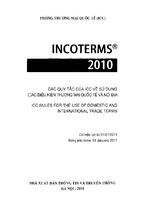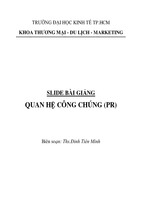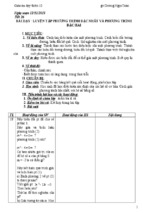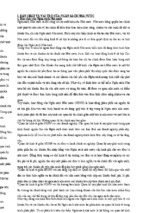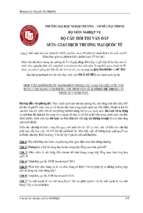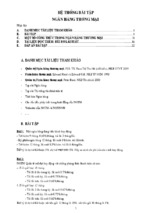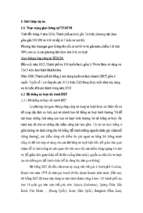APPLYING ARCH-GRARCH MODEL TO IN
ANALYZINGE AND FORECASTING RISKS
FOR STOCKS OF VINGROUP JOINT
STOCK COMPANY’ STOCK (“VIC”)
By
BUI CHIEN THANG
LE HONG HANH
Intake: 12
Tutor’s name:
Prof. Dr. Joel Metais
A Thesis Submitted to
CFVG
ESCP Europe
University Paris Dauphine
In partial fulfillment of the requirements for the degree of
MASTER IN ECONOMICS OF BANKING AND FINANCE
Consulting project_Group 8_MEBF12
Hanoi, June 2016
2|Page
Consulting project_Group 8_MEBF12
Authorization
We hereby declare that we are authors of the thesis.
I authorize CFVG to lend this thesis to
Other institutions or individuals for the purpose of scholarly research.
I further authorize CFVG to reproduce
The thesis by photocopying or by other means, in total or in part, at
the request of other
Institutions or individuals for the purpose of scholarly research.
___________________________________________
[Type under signature line your name]
10/06/2016
3|Page
Consulting project_Group 8_MEBF12
LIST OF CONTENTS
LIST OF ABBREVIATIONS.......................................................................6
ACKNOWLEDGEMENT............................................................................7
CHAPTER I: INTRODUCTION................................................................8
1.
Top Definition...............................................................................................8
a.
Background...............................................................................................8
b. Problem:....................................................................................................8
2.
Research Objectives:....................................................................................9
3.
Research Scope.............................................................................................9
4.
Dissertation Structure...................................................................................9
5.
Conclusion..................................................................................................10
CHAPTER II: LITERATURE REVIEW.................................................11
1.
a.
b.
c.
2.
a.
b.
c.
d.
e.
f.
g.
h.
3.
4.
a.
b.
c.
Definition....................................................................................................11
Stock........................................................................................................11
Stock Market...........................................................................................11
Stock investor..........................................................................................11
Risks of investing in stock market.............................................................11
Market risk:.............................................................................................12
Interest rate risk: .....................................................................................12
Global risk: .............................................................................................12
Business risk: .........................................................................................12
Corporate mis-governance: ....................................................................12
Trading suspension: ...............................................................................12
Liquidity risk: .........................................................................................12
Policy risk: .............................................................................................12
Risk Measurement Method........................................................................12
ARCH......................................................................................................13
GARCH..................................................................................................14
GARCH Family:..................................................................................15
Conclusion..................................................................................................17
CHAPTER III: METHODOLOGY..........................................................18
1.
2.
3.
4.
Research approach......................................................................................18
Method Choice......................................................................................19
Study Type..............................................................................................19
Research Strategy...............................................................................20
4|Page
Consulting project_Group 8_MEBF12
5.
6.
Time horizon..........................................................................................20
Data collection......................................................................................21
a. Data.......................................................................................................21
b. Price and return of VIC..................................................................21
CHAPTER IV: ANALYZE AND FINDING.............................................24
1.
c.
d.
e.
2.
VIC
Overview of VINGROUP join stock company............................24
Corporate Milestones......................................................................25
Business Achivements....................................................................27
Corporate strategy and implementation................................29
Applying ARCH-GARCH to analyse and forecast risks for
36
CHAPTER V: CONCLUSION AND RECOMMENDATION................53
1.
2.
3.
Summary findings...............................................................................53
Recommendation.................................................................................53
Limitation................................................................................................53
REFERENCES
APPENDIX
5|Page
Consulting project_Group 8_MEBF12
ABSTRACT
A Thesis Submitted in Partial Fulfillment of the Requirements for the Degree of
The Master in Economics of Banking and Finance to CFVG
Student’s Name: 1. Bui Chien Thang
2. Le Hong Hanh
Title:
Date: 10/06/2016
1Purpose – This research aims to use ARCH - GARCH model to examine stock return
volatility for Vingroup Joint Stock Company (“Vingroup” or Vingroup JSC”VGR”) for
the period, from 2011 to 2015. In addition, basingBased on analyzing these volatility
characteristics of Vingroup’s stock (“VIC”), investors may seek the precious advices for
their investmentthe appropriate model would be bringing suitable recommendations for
investors and financial policiesBoard of Directors of VGR may find some rolutions to
improve their performance in Vingroup stock..
2Data and SoftwareMethodology – We use Eview 9.0 software. , regression technique
and the forecasting model would be used in this dissertation to build up the model. The
data used in the model are the daily closed price of VIC from 4/1/2011 to
20/11/2015monthly observations follow daily return covering the period from 2011 to
2015.
Findings –This research pointed out the superiority of T-GARCH for forecasting
Vingroup stock volatility. Besides, this dissertation applies two methods including Jarque
Bera, Ljung-Box test to analyze the accuracy and effectiveness of all GARCH models.
The results provide evidence of the advantage of T-GARCH (1,1) in forecasting volatility
compared to other GARCH models. The findings are also illustrated different methods
that used to evaluate the accuracy of prediction.
6|Page
Consulting project_Group 8_MEBF12
Recommendations
-
–From our research, it would use this Garch model to forcast other stocks in the real
estates industry, comparing with VIC in order to choose the best real estate stocks for
investment. The investors could predict stock volatility of Vingroup when recognizing
the movement’s stock return by applying T-GARCH model.
-
It is the good method for advising investors in diversifying investment pofolio,
reducing risks. Combining VIC with other stocks in order to minimising riks
7|Page
Consulting project_Group 8_MEBF12
LIST OF ABBREVIATIONS
ABBREVIATIONS
DEFINITION
VGR or Vingroup
Stock of Vingroup Joint Stock Company
VICIC
Stock of Vingroup Joint Stock Company
WTO
World Trade Organization
TPP
Trans-Pacific Partnership
HASTC
Hanoi Stock Exchange
HOSTCHOSE
Ho Chi Minh Stock Exchange
GARCH
Heteroskedasticity
SBV
State Bank of Viêtnam
8|Page
Consulting project_Group 8_MEBF12
ACKNOWLEDGEMENT
Our consulting project mark our achievements during the course of This thesis is the end
of_the process with our learning and our practice in achieving a Master of banking
Banking and financeFinance held by CFVG.
I would like to express my gratitude to my supervisor Dr. Joel Metais for the useful
comments, remarks and engagement through the writing and learning process of this
master thesis. Furthermore, I would like to thank all Proffesors who taugh us during the
course of Master of Finance & Banking for useful discussions and lectures that helped us
to improve my knowledge in the field of study.
This thesis has been carried out and seeing through to the end with the
encouragement_and support of many people including our supervisor and our classmates.
By the end of this thesis, we wish to thank everyone who helped us complete this
dissertation and gives us a lot of precious experience. We really wish to show thanks to
all those who have contributed so much to the success of this research and make it a
memorable experience for us.
At this time of completed, _firstly we would like to thank to my supervisor, Prof. Joel
Metais for his useful opinions and worth guidance, support for us in the preparation of
this thesis. Under supervisor guidance, we have overcome a lot of difficulties and learned
a lot of lesson.
Finally, we are pleased to thank CFVG_for their support and guidance in our progress to
finish this dissertation.
9|Page
Consulting project_Group 8_MEBF12
CHAPTER I: INTRODUCTION
1.
1.1.
Top Definitions
Background
The stock market is an integral part of the world economy. They offer the many benefits
for private investors, companies and government. For private investors, the stock market
helps investors increase personal income by participating in the trading floor. For
corporate interests, they absolutely can raise capital through the issuance of shares. This
helps companies use large and secure funding to develop and expand production. For the
economy, the stock market is considered as an effective tool to improve the management
and efficiency of the economy. Simultaneously, investment in the stock is also a
reasonable investment channel to capitalize on idle money from individuals in order to
promote economic growth stronger.
Vietnam's stock_market was established in 11/07/1998 referred Decree No._42/CP with
State Security Statement and two Security Trading Centers including Hanoi Stock
Exchange (hereinafter called HASTC) and Ho Chi Minh Stock Exchange (hereinafter
called HOSTCHOSE). So far, it has ever experienced periods of fluctuations with full of
ups and downs follow after volatility of Vietnam economy.
In 2007, Vietnam participated in WTO, the stock market was booming and peaked at a
record of 1171 points. Joining TPP with its position as the country with the least
developed economy, that is why Vietnam is a country will benefit most. So joining the
TPP, whether Vietnam's stock market will have opportunities like the WTO
pariticipation? This is not only the question_but also the expectations of all stock
investors Vietnam.
"Freezing" since 2008, joining TPP is also expected to help Vietnamese real estate market
boom. TPP pariticipation will boost the production activities of foreigners in Vietnam.
Along with that, the real estate business law enacted on 01.07.2015 allowing foreigners to
buy and own houses in Vietnam is expected to attract more capital from outside.
Therefore, the investment in real estate shares on the stock market investors will be
interested as ever.
10 | P a g e
Consulting project_Group 8_MEBF12
1.2. Problems:
Despite many good news to support real estate stocks, however, in order to invest in a
proper way, we still need to know difficultes the analyse and forecasting as well asand the
risks will encounter happen when holding such stocks. In order to choose the good stocks
of real estates industry, we need to supported by apporiate methods/tools. Moreover, the
choice of investing in shares of companies in the real estate sector is also an issue to
consider. Among the listed companies, the public perceptions VPBS, Vingroup is one of
the business to be considered the best for long seasoned investors. Explaining this, that in
the long term VPBS, land becomes more scarce and the cost to expand the land bank will
increase. VPBS believe that the best investment returns will come from the company that
owns a large land bank on the cheap, which is typical VinGroup Corporation.
To In order to help investorsinvestors find the have a proper decision in investing stocks,
perspective and effectiveness of the risk analysis of the stock, Iwe would like to introduce
have studied the subject subject: "Applying ARCH- GARCH model to in analyze
analyzing and forecasting risks of risks of Vingroup’s stock (“VIC”)".
2.
Research Objectives:
The purpose of our research is to model and forecast volatility of returns
for VIC using different types of GARCH models. We are also interested in examining
whether positive and negative shocks have an asymmetric effect on return volatility of
VIC.
We
use
three
different
types
of
Generalized
Autoregressive
Conditional
Heteroscedasticity (GARCH) specifications: the standard GARCH, Exponential GARCH
(EGARCH), and the Threshold GARCH (TGARCH) specifications to model and forecast
the volatility (conditional variance). These models are known to capture the
11 | P a g e
Consulting project_Group 8_MEBF12
characteristics of financial time series such as time varying volatility, non-linearity
dependence, and volatility clustering.
This thesis focuses mainly on the method of how to use ARCH-GARCH model to
analyse and forecasting for VIC stock. The results will provide useful findings on the
volatility of VinGroup stock. AccRely on the insight understandings from the volatility
of VinGroup stockVIC, the oustudy objective is tooff effeve
build anf effective
forecasting volatility model to help investors maximize risk adjusted return when
investing in VinGroup stock.
3.
Research Scope
This research focuses on using ARCH-GARCH model in analysing and forecasting VIC.
Thesis research focuses on analyzing and the building the forecasting volatility models
for VinGroup stock. With this forecastingIn these models, the our study will gather data
of closed daily price of VIC from The Stock Exchanges in Ho Chi Minh City-HOSTCE
with VIC stock. VIC stock will be collected daily, weekly and monthlythe data was
collected from 4/1/2011 to 20/11/2015. in the 2011-2015 periods to input to ARCHGARCH model to analyse and forecasting for Vingroup stock.
4.
Dissertation Structure
This research was constructed to five chapters:
Chapter 1: Giving a panorama picture of the topics which includes introduction
problem, research questions, research objective and thesis structure.
Chapter 2: Reviewing all literature reviews.
Chapter 3: Offering methodologies that applied to collect data, processes to test for all
related models, ethical consideration, and research limitation.Our Methodology
Chapter 4: Analyzing and discussing of results related to the literature review.
Applying ARCH-GARCH model to analyse and forecast volatility of VinGroup stock
volatility.VIC
12 | P a g e
Consulting project_Group 8_MEBF12
Chapter 5: Providing the findings and recommendation over the dissertation.
5.
Conclusion
Summing up, in the chapter 1, it has highlighted a general introduction to Vietnam's stock
market and VinGroup stock as well as the current problems still appear on the market.
Based on this general introduction, chapter 1 of the study was identified the objective of
the research is focused on analyzing VinGroup stock from 2011 to 2015. At the same
time, Chapter 1 also provides the structure of the whole thesis as orientation for the study
analysis.
13 | P a g e
Consulting project_Group 8_MEBF12
CHAPTER II: LITERATURE REVIEW
1.
Definitions
1.1. Volatility
There has been considerable volatility ( (and_ uncertainty) in the past few years in mature
and emerging financial markets worldwide. Most investors and financial analysts are
concerned about the uncertainty of the returns on their investment assets, caused by the
variability in speculative market prices (and market risk) and the instability of business
performance (Alexander, 1999). Volatility has become a very important concept in
different areas in financial theory and practice, such as risk management, portfolio
selection, derivative pricing.
In stock market, volatility is the key systematic risk faced by investors who hold a market
portfolio (Schwert,1989) and investors want a premium for investing in these risky assets.
The degree of stock market volatility can help forecasters predict the path of an
conomy‟s growth and the structure of volatility can imply that investors now need to
hold more stocks in their portfolio to achieve diversification”(diversification” (Krainer
2002).
ThereforeTherefore, the definition of volatility has been mentioned in research study.
Volatility is the range at which prices move higher or lower that unexpected, and how
wildly they swing by Kimberly Amadeo (2012). Pooter (2007) also defined volatility of
stock market as variability of the unforeseen random elements of a time series variable.
By Black & Scholes (1973) volatility was ever mentioned in the formula as a component
for pricing derivatives. Simultaneously in recent years, the volatility index of stocks has
been interested and calculated as a financial tool to help investors make investment
decisions for any securities.
1.2. Measurement of Volatility
Stock volatility is indicators that investors often use the option to search the changing
level in trends on the stock market. It exists two value is used to measure the volatility in
14 | P a g e
Consulting project_Group 8_MEBF12
stock market including historical volatility (standard deviation) and implied volatility.
Based on the characteristics of each measurement value as well as the strengths and
weaknesses the study will select suitable values to focus volatility forecasts:
Historical Variance (standard deviation)
The standard deviation is often represented for the actual volatility. Mainly, it based on
historical data to estimate stock volatility.
Fluctuation of stock returns would be
measured by capturing the movement of stock returns and set a mean value from
collected data in the past. It would be suggested that long-term investment should be
focused on by estimating historical stock return. The equation mentioned as follow:
Historical volatility is the standard deviation of returns that was in the logarithmic form.
Therefore, to some extent, volatility and standard deviation are the same. However, both
of them still exist some keys different which should be considered. Any distribution of
the underlying asset could be built from the standard deviation. But this distribution is
only meaningful when the value of the standard deviation tends to the normal distribution
N (- 1,1). In other words, the standard deviation will be considered a measure of the value
volatility when its returns is associated with a certain distribution. Most researchers have
assumed that it become to the normal distribution of stock return.
Implied Variance
Implied Variance has a different approach to Historical Variance in estimating volatility.
This approach was introduced firstly by Rendleman and Latane (1976). It considered
future volatility as the volatility of option returns in the lifetime. Implied Variance is set
as a vital role in the trading of option that can be helpful when determining the certain
price level stock in specific time. Implied volatility is replied on general consensus in the
marketplace, it shows the extent of potential stock returns movement. But the trend of
stock returns werewas not known exactly.
15 | P a g e
Consulting project_Group 8_MEBF12
Based on analyzing the characteristics of each value is used to measure volatility is
Historical Variance and Implied Variance, both of them are often used as a shorthand way
to determine whether an option is expensive or not expensive. Because the study focused
forecasts of market volatility Vietnam in 2009-2013, the Variance historical value
measurement is considered to be an appropriate choice. Historical volatility preferred to
as the return’s realized or actual volatility. There are several different
ways to measure historical volatility. This study use so called close-toclose volatility. Moreover, financial market in Vietnam is not yet
formed derivative financial markets, the volatility of measurement
selected by Implied Variance will not exactly enough to make definitive
conclusions for the study.
16 | P a g e
Consulting project_Group 8_MEBF12
2.
Stock
3.
A stock is a type of security that signifies ownership in a corporation
and represents a claim on part of the corporation's assets and earnings.
There are two main types of stock: common and preferred.
4.
Common stock usually entitles the owner to vote at shareholders'
meetings and to receive dividends.
5.
Preferred stock generally does not have voting rights, but has a higher
claim on assets and earnings than the common shares.
6.
For
example,
owners
of
preferred
stock
receive dividends before common shareholdersand have priority in the
event that a company goes bankrupt and is liquidated.
7.
Stock Market
8.
A stock market, equity market or share market is the aggregation of
buyers and sellers (a loose network of economic transactions, not a
physical facility or discrete entity) of stocks (also called shares); these
may include securities listed on a stock exchange as well as those only
traded privately.
9.
Stock investor
10. A stock investor is an individual or company who puts money to use by
the purchase of equity securities, offering potential profitable returns, as
interest, income, or appreciation in value (capital gains).
11. Risks of investing in stock market
17 | P a g e
Consulting project_Group 8_MEBF12
12. When you invest in a stock market, it is important to understand the
risks and know your limits. You should also be aware that while you
might make gains, you could also lose. Among the major risks you
should watch out for include:
13. Market risk: Stock prices can be very volatile and unpredictable subject
to
different
market
and
economic
factors
both
locally
and
internationally. Market risk, also known as systematic risk, usually
refers to that type of risk associated to a specific market. It stems from
the economic, geographical, political, social or other factors of that
market. You may click here to know more about systematic risk.
14. Interest rate risk: Shifts in interest rates may affect different stock
prices to different extents.
15. Global risk: a stock market is open and it is therefore influenced by
economic issues in all major markets. You are therefore exposed to
economic events around the globe and need to factor this into your risk
assessment.
16. Business risk: A listed company you invest in may suffer a severe decline
in profits or even go bankrupt. This could be a result of many factors
such as poor management, slowdown of the industry and competition.
17. Corporate mis-governance: A company you invest in may have
improper management or conduct a transaction that you deem is
detrimental to your interests as a shareholder e.g. a company buys an
over-valued asset. The regulators do not normally intervene in
commercial decisions of listed companies provided there is no breach of
regulations.
18 | P a g e
Consulting project_Group 8_MEBF12
18. Trading suspension: A stock can be suspended from trading to avoid
any uneven information dissemination and opportunities for insider
dealing and to ensure trading is undertaken on a fully informed basis.
You will not be able to buy or sell a stock during suspension during
which time the price may move due to both market and business risk
changes.
19. Liquidity risk: Beware of the additional risk of being tied up in stocks
which are hard or costly to liquidate. Stocks with low capitalisation are
generally less liquid than those with high capitalisation.
20. Policy risk: Changes in government policies and regulations could have
profound impact on stocks in the relevant sectors or industries.
21. Risk Measurement MethModel for forcasting risksod
There are many methods to forcasting risks. However in this dissertation, report will
focus analysis on ARCH - GARCH models to predict the volatility of stocks. "VaR of a
portfolio of financial assets represents the loss that may occur in a certain time period
with a predetermined confidence level. Determine VaR will help policy makers to better
manage market operations, while the investors, financial institutions estimate the
financial risk of their loss. ". There are many methods, such as VaR estimate: Method past
data; Method Variance - covariance; Risk Metrics methodology; Method of Monte Carlo Method and application Arch-GARCH model. However, in this thesis, we only
focus on the application of Arch-GARCH model, we will just focus on introducing this
model, as follows:
2.1.
ARCH
“ARCH (Autoregressive Conditional Heteroskedasticity)” was proposed by Engle (1982)
in research study. Many research of previous study as Bollerslev, Engle, and Nelson
(1994) and Bollerslev, Chou, and Kroner (1992) were supported more information about
this model. Reviewing the basic ARCH models also mentioned in lots of general financial
19 | P a g e
Consulting project_Group 8_MEBF12
document, including Davidson and MacKinnon (1993, 2004), Greene (2012), Kmenta
(1997), Stock and Watson (2011), and Wooldridge (2013). ARCH models used the
"conditional heteroskedasticity” to estimate the volatility for stock market. ARCH
regression models including the volatility of a series varies over time. Generally, ARCH
models base on the past volatility to predict for future volatility based on. In ARCH (q)
models, the conditional mean and conditional variance of the dependent variable are
written:
2�� Symbol for the time series conditional variance with the q lagged terms. Besides,
all �= (�0,�1,…,�� ) are variable in ARCH model.
Basing on the equation, ARCH model totally may predict and estimate the volatility for
stock market. However, ARCH still exists some disadvantages when determining the
lagged term for model. It means that ARCH model is really difficult to determine the q
lagged which required q is large.
2.2.
GARCH
According to effect of ARCH models, the research can predict the volatility for stock
market but it's not entirely accurate enough to determine the volatility that the q that day
in ARCH effect in equation has not been determined. Taylor (1986) and Bollerslev (1986)
solved the problem that ARCH which could not cover q lags of past by suggesting the
GARCH (p,qp, q).
According to Taylor (1986), Bollerslev (1986) and Engle (1982), GARCH (p,q) is added
q lags of past from ARCH (q). Based on that, all the q lags can be estimated by GARCH
(p,q) in the past, it is considered as “ autoregressive and moving average variance”. The
result illustrated this model is more suitable and high realistic than the others. The
formula of GARCH (p,q) has written below:
20 | P a g e
- Xem thêm -

